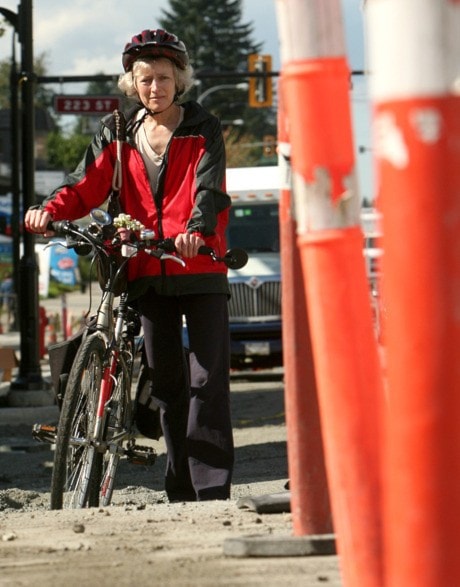Getting people out their cars and on to their bikes will take more than a thin, white line.
Those bike lanes appeal only to the one per centers, the kamikaze commuters among the two-wheeled crowd who ride regardless of traffic.
Instead, bike lanes should be separated by a curb or barrier so cyclists don’t feel they’re about to be creamed by an approaching SUV or car. Or more traffic-calmed streets should be built where cyclists feel safer.
“We have to start focusing on the largest group of people who want to go on short trips,” said Jackie Chow, with the Vancouver Area Cycling Coalition.
The current emphasis on bike lanes for the one per cent of bike commuters labeled as “strong and fearless,” isn’t working right now, she said.
That largest group of potential cyclists is called the “interested and concerned” portion of the general population, about 60 per cent, who would get on a bike, but fear for their lives when they do so.
The labels come from a cycling conference in Portland, Ore., where commuters were divided into four types: “the strong and fearless,” and the enthused and confident, who make up six to seven per cent of cyclists; the majority, 60 per cent, who are “interested but concerned;” and the remaining 30 per cent who’d never get on a bicycle anyways.
Chow said TransLink’s cycling strategy study has shown that planners have focused on the “strong and fearless” and the “enthused and confident crowd” while basically ignoring the needs of the largest segment, the “interested but concerned.”
Chow was commenting following a recent presentation by transportation specialist Richard Drdul, who has worked with more than 30 cities across Canada on bicycle infrastructure. The local Vancouver Area Cycling Coalition and the bicycle advisory committee hosted the evening.
The current strategy of painting white lanes to mark off bike lanes on roads is a waste of money because it hasn’t increased the number of cyclists.
For instance, between 1996 and 2006, about $100 million was spent in the Metro Vancouver on cycling infrastructure. But during that time the rates of cycling in Vancouver/UBC have only increased from 3.4 per cent to 3.8 per cent, and remained at one per cent in the rest of the region, she said.
Building only separated bike lanes would be expensive, but Chow pointed out that each motor vehicle owner spends about $7,000 year on their vehicles.
“It’s a humongous amount and people don’t realize that.”
Although they were all invited, no one from Maple Ridge council attended. Coun. Mike Morden, who’s on the bicycle advisory committee, had a previous commitment, and only Coun. Dave Murray from Pitt Meadows attended, although municipal staff were present.
Chow said cyclists prefer neighbourhood trips, want access to key destinations, along with safe and convenient parking and signage.
Drdul pointed out that 40 years ago, only four per cent of trips in Copenhagen, Denmark were made by bicycle. Now that percentage has grown to 40 per cent, since planners began focusing on the “interested but concerned” category.
Council is set to review the bylaw allowing cyclists on sidewalks, although that’s not on the present work plan.
Morden, though, doesn’t like the bylaw and says cyclists should be on the road, unless they’re walking their bikes. He doesn’t cycle because of a back injury.
Russ Carmichael, director of engineering operations for Maple Ridge, said an assessment was done last summer of the bike route network in Maple Ridge and Pitt Meadows. The results of this exercise will be used to prepare the new bikeways plan and map over the coming months.
